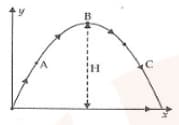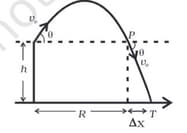Projectile Motion
Important Questions on Projectile Motion
A particle falling vertically from a height hits a plane surface inclined to horizontal at an angle with speed and rebounds elastically as shown in the figure. Find the distance along the plane where it will hit the second time.

A gun can fire shells with maximum speed and the maximum horizontal range that can be achieved is .If a target farther away by distance (beyond ) has to be hit with the same gun as shown in the figure here. Show that it could be achieved by raising the gun to a height at least .
A hill is high. Supplies are to be sent across the hill using a canon that can hurl packets at a speed of over the hill. The canon is located at a distance of from the foot of the hill and can be moved on the ground at a speed of ; so that its distance from the hill can be adjusted. What is the shortest time in which a packet can reach on the ground across the hill? Take .
A fighter plane is flying horizontally at an altitude of with speed . At What angle of sight (w.r.t horizontal) when the target is seen, should the pilot drop the bomb in order to attack the target?
In dealing with the motion of a projectile in the air, we ignore the effect of air resistance on the motion. This gives trajectory as a parabola as you have studied. What would the trajectory look like if air resistance is included? sketch such a trajectory and explain why you have drawn it that way.
A boy throws a ball in the air at to the horizontal along a road with a speed of . Another boy sitting in a passing by car observes the ball. Sketch the motion of the ball as observed by the boy in the car, if the car has a speed of . Give an explanation to support your diagram.
A boy travelling in an open car moving on a levelled road with constant speed tosses a ball vertically up in the air and catches it back. Sketch the motion of the ball as observed by a boy standing on the footpath. Give an explanation to support your diagram.
A ball is thrown from a rooftop at an angle of above the horizontal. It hits the ground a few seconds later. At what point during its motion, does the ball have greatest acceleration? Explain.
A ball is thrown from a rooftop at an angle of above the horizontal. It hits the ground a few seconds later. At what point during its motion, does the ball have smallest speed?
A ball is thrown from a rooftop at an angle of above the horizontal. It hits the ground a few seconds later. At what point during its motion, does the ball have greatest speed?
 A particle is projected in the air at some angle to the horizontal, moves along the parabola as shown in the figure, where and indicate horizontal and vertical directions respectively. Show in the diagram, direction of velocity and acceleration at points and .
A particle is projected in the air at some angle to the horizontal, moves along the parabola as shown in the figure, where and indicate horizontal and vertical directions respectively. Show in the diagram, direction of velocity and acceleration at points and .

A particle slides down a frictionless parabolic track starting from rest at point as in figure. Point is at the vertex of parabola and point is at a height less than that of point . After , the particle moves freely in air as a projectile. If the particle reaches highest point at , then

.
Two particles are projected in air with speed at angles and , (both acute) to the horizontal, respectively. If the height reached by the first particle is greater than of the second, then tick the right choices
In a two dimensional motion, instantaneous speed is positive, constant. Then which of the following are necessarily true?
The horizontal range of a projectile fired at an angle of is . If it is fired with the same at an angle of . Its range will be:


